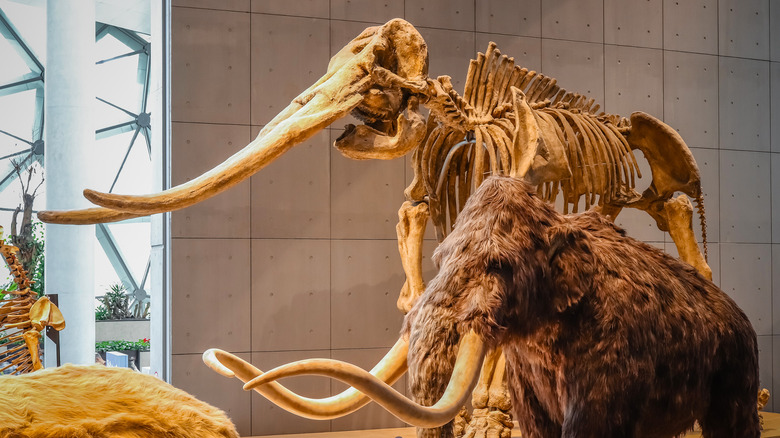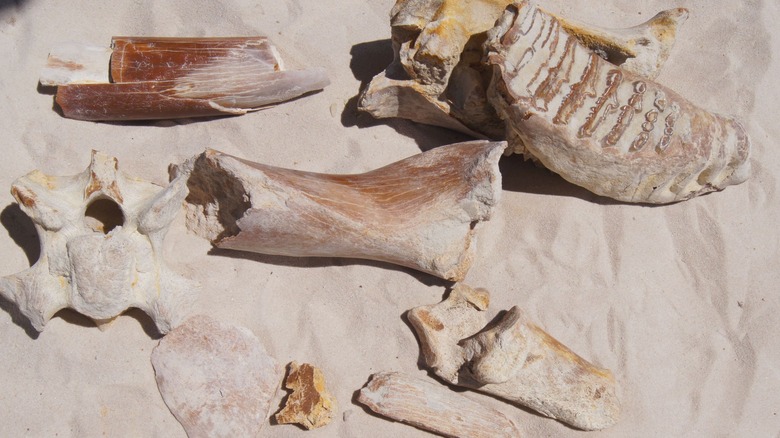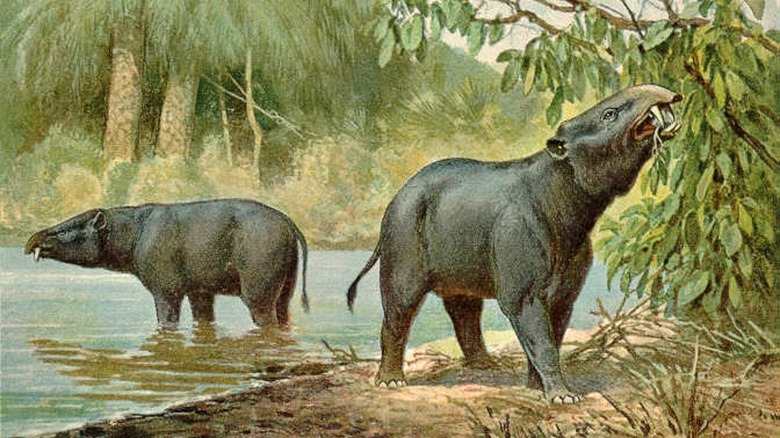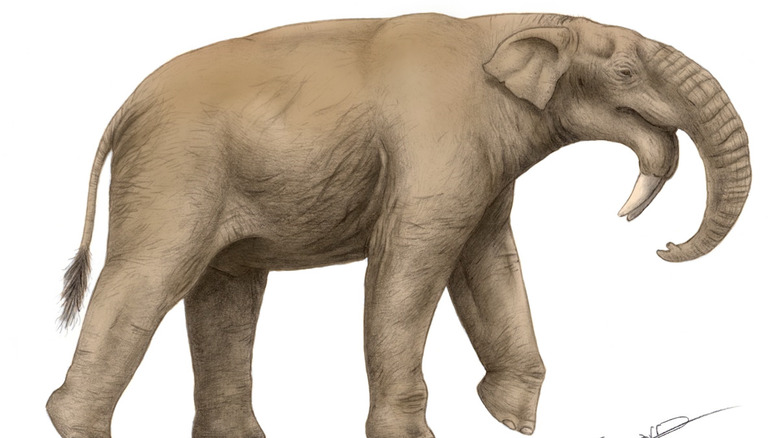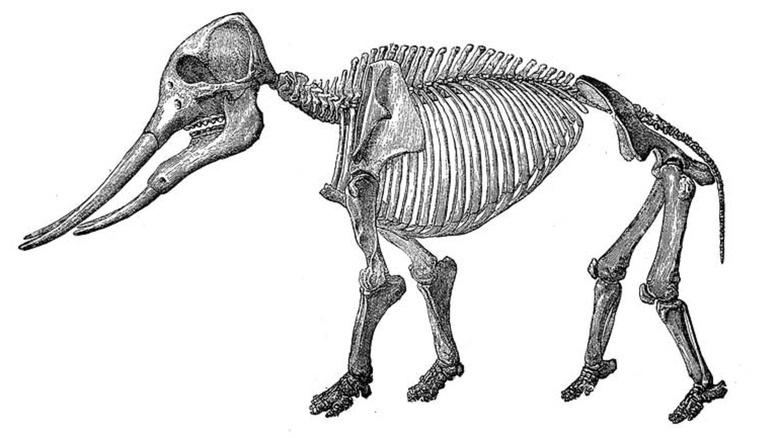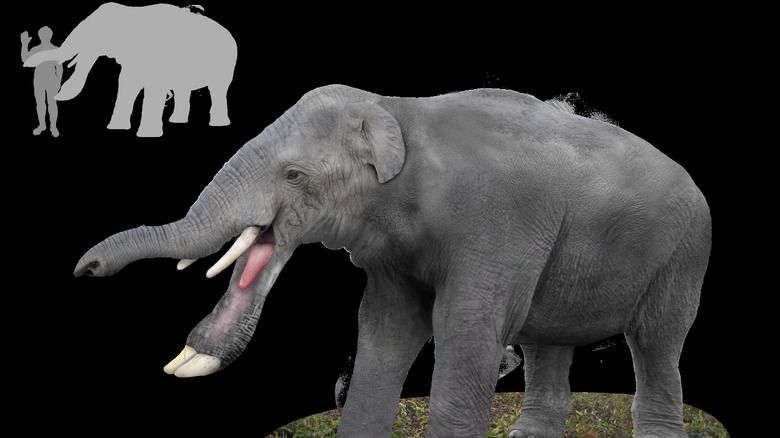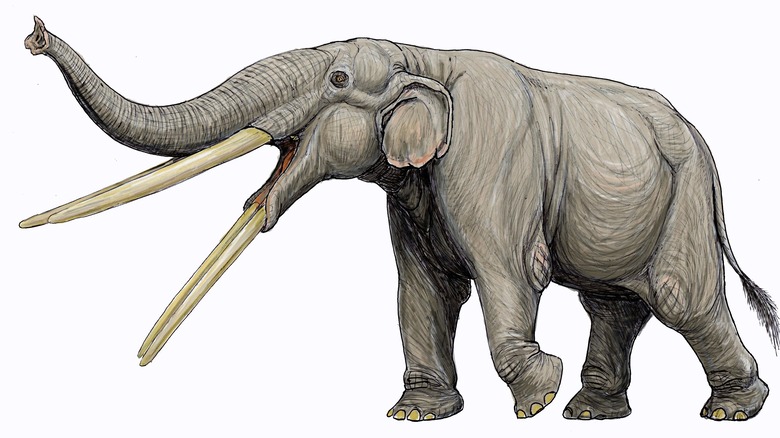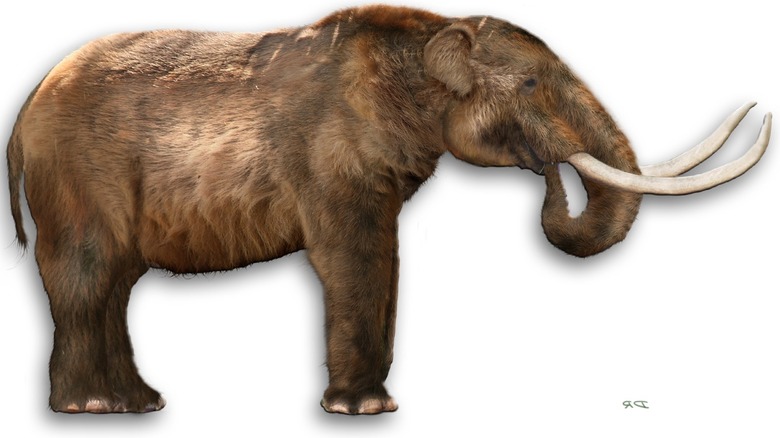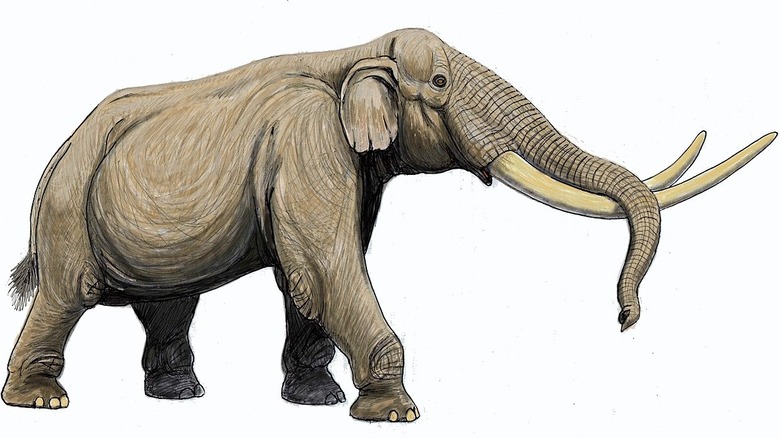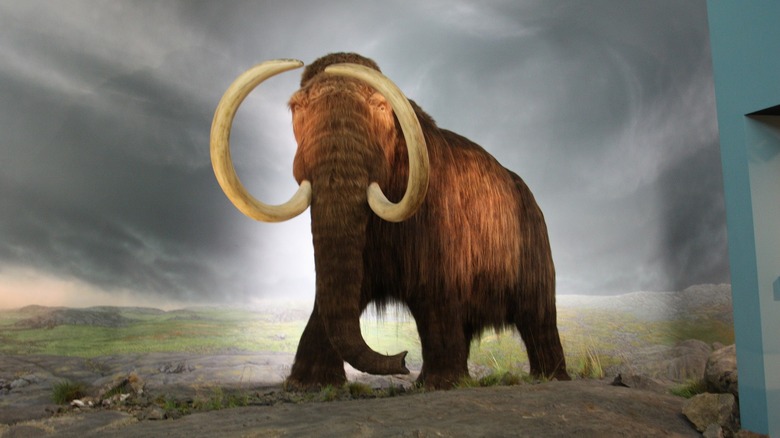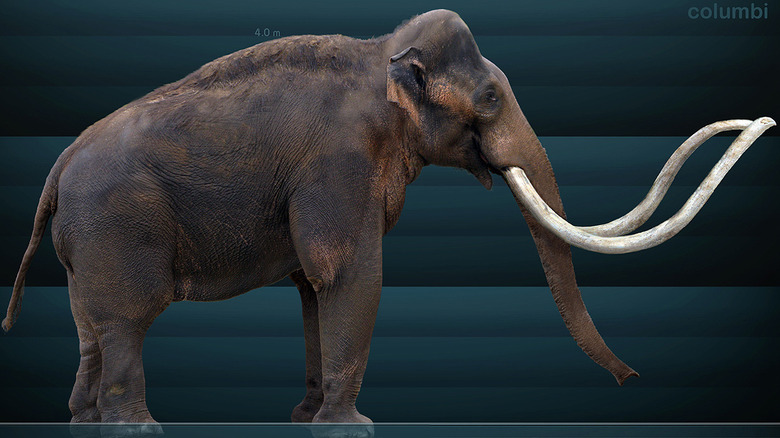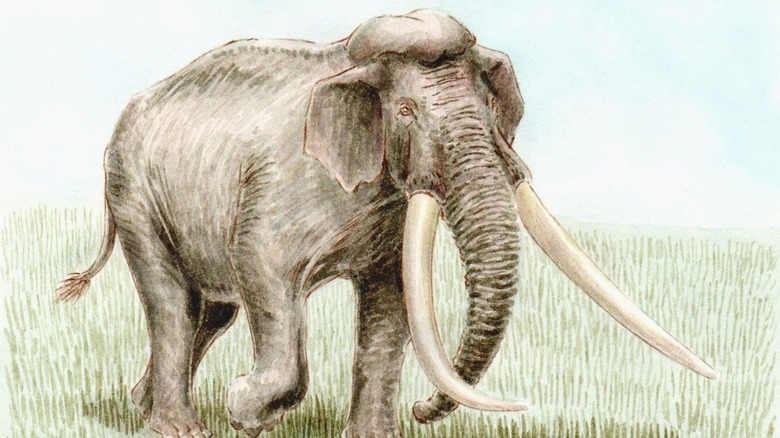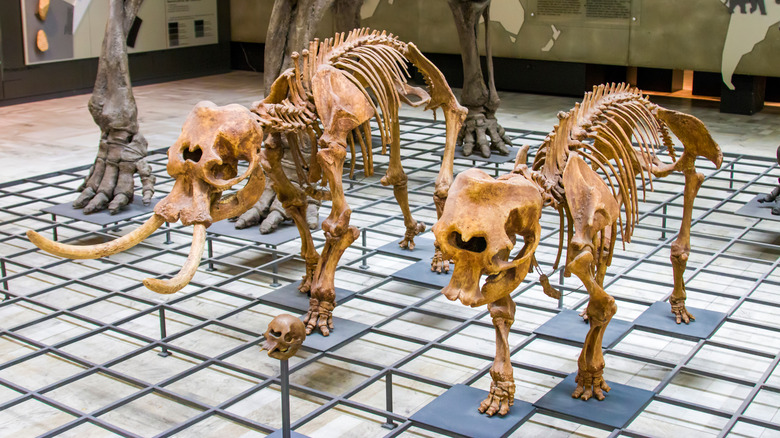The Real Reason These Prehistoric Elephants Went Extinct
With its snake-like trunk and immensity there is no animal more recognizable than the elephant. According to the World Wildlife Fund, the elephant is the largest land animal alive today represented by three species: the very large African savanna elephant, the smaller African forest elephant, and the Asian elephant. These species are the survivors of an illustrious evolutionary lineage which included dozens of different species of elephant or closely-related elephant species.
The "Princeton Field Guide to Prehistoric Mammals" provides an overview of elephant evolution that stretches back to at least 55 million years ago. This lineage, as a whole, is given to the scientific order Proboscidea. This name refers to the proboscis, the mobile snouts and trunks of these animals. The Proboscidea had at least five divergences into major elephantine families containing numerous species, some of which were very strange indeed. So what happened to all these extinct elephants?
Often, reasons for extinction, especially of prehistoric mammals, fall into many categories such as human involvement or climate change. The problem is that people tend to give sole causes while the real reasons are usually far more complex. In fact, in some cases it is arguable that some species of proboscideans never went extinct, but merely evolved into new forms. To understand the extinction of the prehistoric elephants and their relatives you need to understand them and how they lived. In this way, you can better understand how they could no longer survive.
Eritherium
One of the earliest of the proboscideans was Eritherium azzouzorum which, at about 11 pounds, seemed more suited for a petting zoo than wide savannas or dense jungles. Science Daily explains that this small mammal is known from remains in Morocco where it roamed roughly 60 million years ago, about 5 million years after the extinction of the dinosaurs. Eritherium was an important ancestral species, with the "Princeton Field Guide to Prehistoric Animals" placing them as the common ancestor of not only all the Proboscidea, but manatees and dugongs as well.
What we know about Eritherium is limited and based on, as the Guardian reported, partial fossils from about 15 individuals. However, these findings allowed scientists to determine its relation to later elephants through cranial and dental examination. Although this primitive creature probably lacked a trunk, it did, however, have an enlarged incisor which was the precursor to the tusks of later proboscideans. It is in this way that Eritherium did not so much go extinct, but evolved into the larger animals of the elephant order.
Moeritherium
During the Eocene Epoch (55.8 to 33.9 million years ago) proboscidean evolution stepped up with the appearance of the genus Moeritherium in northern Africa. According to Britannica, this animal was bigger than earlier proboscideans, but it still did not look anything like an elephant. Rather, if you were to go back in a time machine and look at a Moeritherium, you might understandably confuse it with a South American tapir, since it closely resembled one in shape and size. The animal likely had a flexible snout (like a tapir) which was the apparent forerunner of a trunk. In addition, its upper and lower incisors were developing into four tusks.
National Geographic suggests that Moeritherium lived in freshwater, such as in rivers or swamps because chemical signatures from fossilized teeth show evidence of a diet of freshwater plants, meaning Moeritherium was at least semi-aquatic. As for what happened to Moeritherium, it is likely that it or another similar proboscidean gave rise to later elephants.
Deinotherium
Eventually, the elephant's early ancestors left an aquatic existence for terrestrial life. According to "Life Through the Ages," this spurned rapid evolutionary development. Generation by generation, these animals grew larger and larger. Tusks evolved into various shapes depending on what was needed for survival. One of these early giants, and cousin to today's elephants, was the genus Deinotherium, which had at least three species which roamed Africa and Eurasia from the Miocene to the Pleistocene.
An African elephant today weighs, according to National Geographic, up to seven tons with a maximum height of 13 feet. A Deinotherium could exceed that height but also had a lot more weight — up to 10 tons. Yet what made Deinotherium stand out from modern elephants is that it had two downward curving tusks on its lower jaw — the opposite of an elephant today. A certain amount of conjecture has been given as to how Deinotherium used these chin tusks. Originally, it was thought to be used to dig up the ground searching for food. However, through examination of the ancient markings on the tusks, it is more likely that Deinotherium used them to strip bark off trees, or even pull trees down.
The reasons for their disappearance are not clear. According to "Lothagam: The Dawn of Humanity in East Africa," Deinotherium died out in Eurasia by the time of the Pliocene, possibly due to climate change. However, a remnant population hung on in Africa until the early Pleistocene about 2.5 million years ago.
Gomphotheres
The Gomphotheres were a large group of proboscideans which usually had four tusks. According to Britannica, this group included numerous species, and it is still unclear if this group was the direct ancestors of today's elephants or a sister group. In fact, although they are extinct now, the Gomphotheres were the most numerous and widespread proboscidean group between 23 million to 11,700 years ago. They had even reached South America after that continent first linked to North America some 2.8 million years ago (according to Smithsonian).
Gomphotheres thrived and diversified into numerous species right through the end of the Miocene about 5.3 million years ago. After that, the group's diversity declined. There seems to be two reasons for this. First, more modern elephant species had developed, and possibly Gomphothere species declined from this competition. Second, their extinction was probably exacerbated by climate change at the time which cooled Earth's atmosphere and changed ecosystems. However, some Gompotheres managed to hang on. Remains were found at human sites in the Americas as early as 12,000 years ago. Perhaps these last, stressed populations may have been pushed over the edge through human exploitation.
Platybelodon
One unusual gomphothere was Platybelodon. According to the "Dinosaurs and Other Prehistoric Life," Platybelodon looked mainly like elephants except that their lower jaw was extended out in what looked like a large spade or shovel. Platybelodon was not alone in this evolutionary design choice. As Scientific American explains, this morphology occurred in other elephant relatives such as Amebelodon.
These so-called "shovel tuskers" ranged worldwide and were originally thought to have used its lower mandible to scoop up mud from ponds or swamps to gobble up the plants contained therein. However, as NPR reported, this view was revised in the 1990s after a close examination of Platybelodon's beveled teeth showed that it was more likely that it used its mouth to grasp onto trees and saw. It then ate coarse vegetation and twigs.
Whether a shoveler or a sawer, these animals were definitely specialized. Specialization leads to vulnerability since you would struggle to adapt if your environment suddenly changes. "The Living Elephants" notes that a global cooling trend at about 10 million years ago led to the growth of grasslands and arid conditions. It is likely that these conditions led to their extinction at that time.
Stegotetrabelodon
The mouthful of a genus name that is Stegotetrabelodon is probably the direct ancestor of mammoths and today's elephant. "Adventures in the Bone Trade" points out that this Miocene animal differed from today's elephants because it had two long lower tusks in addition to the two upper ones. Scientists, as detailed in "Mammoths," have been able to trace the ancestry of today's elephants to Stegotetrabelodan through an examination of the teeth of which all species had flat-ridged molars.
Recent findings have also shown that these animals behaved like modern elephant species. Live Science reported that paleontologists discovered 7 million year old fossilized tracks of 13 Stegotetrabelodon individuals in the Arabian desert which, at that time, was a flourishing wetland filled with large herding animals. The tracks were made as individuals walked through the mud. This is the first direct evidence of elephant herding behavior. In addition, solitary tracks from a presumably lone male shows that there was a structured society. While the reasons for Stegotetrabelodon extinction are unknown, it is likely that the changing climates played a role for those lines that did not evolve into the mammoths and elephants.
Mastodons
Mastodons looked like elephants, undoubtedly had many of the same behaviors as elephants, but were in fact just a distant cousin which co-evolved with many of the same traits. Still, Mastodons did have some key differences from elephants. Their teeth were more primitive, their skulls lower and simpler, the ears were smaller, they were generally shorter (though strongly built), and males also had two short lower tusks. They also were covered with reddish hair.
According to Live Science, Mastodons first appeared 27 to 30 million years ago. While their geographic range was worldwide, according to Britannica, their concentration was primarily in Central and North America. Mastodons lived until 11,000 years ago with their last home in North America. Their extinction, as reported by the Guardian, seems to be rooted in climate change. When the climate warmed, mastodons migrated as forests grew (their usual habitat). However, as cooling came with an ice age, forest receded and populations became isolated. This reduced genetic diversity. Finally, human hunting probably contributed to their final extinction.
Stegodon
From the late Miocene to the late Pleistocene (2.5 million to 11,700 years ago) a family of proboscideans called the Stegodons roamed Africa and Asia. As described by "Direct dating of Pleistocene stegodon from Timor Island, East Nusa Tenggara," this group radiated into a large variety of species. Stegodons are most closely related to today's Asian elephants with some notable differences. Phys.org points out that one species, Stegodon orientalis, had, in comparison, a longer and lower slung body than Asian elephants.
Stegodons lived at the same time as Asian elephants in their own separate herds. This brings up the obvious question of how can two massive animals live together in large numbers without depleting all available resources? The answer is that they had different feeding habits and habitats. The stegodon was a forest dweller while the Asian elephant ate vegetation from both open savanna and wood.
Diet may have been the primary culprit for stegodon's extinction. The flexibility of the Asian elephant's dietary habits allowed it to adapt to changing climatic conditions while the stegodon was placed under stress. As the climate shifted between ice ages coupled with volcanism, the stegodon died out because it could not easily adapt to changing conditions.
Wooly mammoth
The mammoth is undoubtedly the best known group of extinct proboscideans and is the poster child for ice age fauna. According to Britannica, this close relative of elephants roamed throughout North America, Eurasia, and Africa during the Pleistocene and was directly hunted by humans. Of the various species of mammoth, the most famous is the wooly mammoth (mammuthus primigenius), so-called for the shaggy reddish coat that covered its immense body.
The wooly variety is most known because of the amount of well-preserved findings, with some specimens being wholly frozen in permafrost ice within the Arctic circle. The quantity of material to analyze has led to several theories as to why wooly mammoths went extinct.
One primary reason as explained by Smithsonian is that climate change led to warmer climates at the end of the last ice age and disrupted the wooly mammoth's tundra habitat through the growth of forest. This led to isolated populations which became genetically inbred. These stresses were made worse through hunting by human populations. The last wooly mammoth population lasted on Wrangel Island in the Arctic Circle until they experienced a level of inbreeding that led to extinction. However, because of the amount of available DNA from recovered specimens, CNN reports that scientists are working to try to resurrect this extinct animal.
Columbian Mammoth
There were a variety of mammoth species, and the largest was the Columbian Mammoth (mammuthus imperator). According to the National Park Service, this species of mammoth evolved from earlier wooly mammoths that had migrated from northern regions to the south. The Columbian Mammoth was found throughout southern North America and into Central America. Almost all of today's United States would have had Columbian Mammoths thundering about in it. Like other mammoths, the Columbian lived in large herds devouring as much vegetation as it could so that it could grow.
And grow it did. Columbian Mammoths were of a massive size, being up to 11 tons and 13 feet at the shoulder. And while they were indeed mammoths, they lacked the wooly hair of their northern kindred.
This mammoth, like other mammoths, was hit by a warming climate at the end of the last ice age that altered its environment. They died off after humans first migrated into the Americas and disappeared between 13,000 and 10,000 years ago.
Straight-tusked elephant
At nearly 15 feet high and over 14 tons, the straight-tusked elephants were the largest elephants ever to exist and possibly the largest land mammal to have ever walked the earth. The U.K.'s Natural History Museum reports that this genus, Palaeoloxodon, was highly widespread during the last million years with a variety of species occurring first in Africa, then radiating through Eurasia, even colonizing Japan. Adaptable, the species changed as it spread east from grazing behavior to a browser. This is presumably to avoid direct competition with mammoths. Straight-tusked elephants were so successful that they evolved into several species, the largest of which was Palaeoloxodon namadicus. It is debated whether this species or Indricotherium, a huge hornless rhinoceros that lived some 24 million years prior to this animal, was larger.
Aside from their enormity, straight-tusked elephants are recognizable by a band that ran around individual skulls (presumably to help support the massive head) and, naturally, its somewhat straighter tusks. Also in comparison with other elephants there was greater sexual dimorphism — that is, differences between sexes. Research published in Nature contends that the males were much larger than the females and kept growing until their 50s.
These animals survived until about 21,000 years ago and definitely interacted with humans. A paleolithic site in Italy shows evidence of butchery. However, it is unclear what role humans had in the extinction of straight-tusked elephants. It seems likely that the wild swings of climate during the ice ages played a role.
Dwarf elephants
The biggest elephants ever were the straight-tusked elephants (via the Natural History Museum), but ironically, their stock gave rise to the smallest. As these elephants migrated through the world, some colonized islands, such as those in the Mediterranean. New Scientist relates how they quickly morphed into much smaller species through an evolutionary process called island dwarfism.
How much smaller did these elephants get? Palaeoloxodon mnaidriensis found on Sicily was shown to have lost over 17,500 pounds in weight and over 6.5 feet in height. Incredibly, the rate of evolutionary change was so intense that researchers believe that this species lost about 440 pounds per generation. The New York Times reported that at this rate, it could theoretically only take 40 generations for the elephants to reach dwarf size, though in reality it was probably anywhere up to 352,000 years. The smallest of these dwarf elephants was, according to the Natural History Museum, Palaeoloxodon falconeri, which lived on Sicily and Malta. A bull elephant of this species barely topped an adult man's waist.
In island populations, there is not as much genetic diversity with a smaller population which makes them vulnerable to extinction events. It is believed that climate change and tectonic activity such as volcanism led to the extinction of falconeri some 400,000 years ago. Mnaidriensis survived until about 19,000 years ago.
